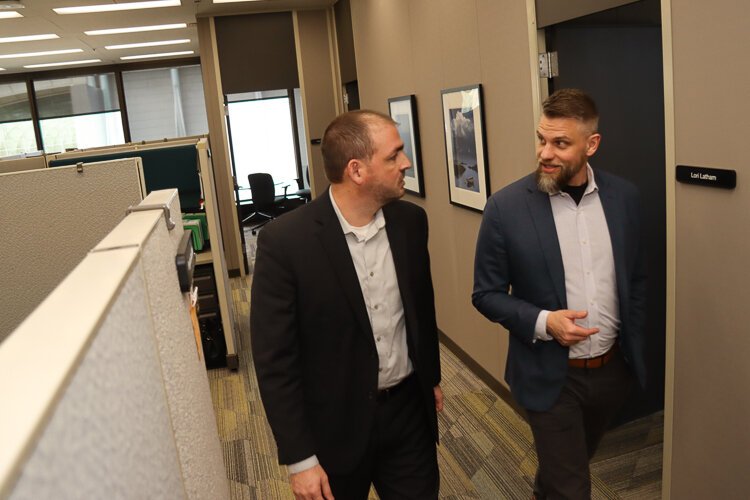What’s next for housing in Kent and Ottawa counties
As Kent County grows faster than the rest of the state, the community looks at ways to address its ongoing housing shortages.

This article is part of the Block by Block series, supported by FHLBank Indianapolis, IFF, and the Community Economic Development Association (CEDAM). Block by Block follows small-scale minority-driven development and affordable housing issues in the state of Michigan.
Located in Kent County, Grand Rapids is growing faster than the rest of the state in terms of population growth. Kent County has grown five times faster than the state since 2010. Even though the state’s population is expected to decline over the next five years, the City of Grand Rapids and Kent County are poised to do the opposite. Grand Rapids is a suitable, attractive, diverse community that many people want to stay in and even move to. That sounds like a good problem, right? Well, not when the area is experiencing housing shortages.
According to a new Housing Next study, there is currently a housing gap with nearly 35,000 units needed by 2027. That’s almost a 59% increase since 2020. Although this number includes units at all price points, lower- and middle-income residents account for over half of those looking to buy homes and rent units.
Housing Next, a regional partnership in West Michigan, focuses on issues surrounding housing supply. Partnering with local government, developers, and nonprofits, the organization believes in a holistic approach to housing. They aim to remove barriers and create housing at all price points.

Chris Uhl is the executive director of the Eastern region for IFF, which began in 1988 as a loan fund to lend money to nonprofits to help develop real estate. This community development financial institution (CDFI) has invested more than $1.4 billion in nonprofits like Housing Next through community-centered lending throughout the Midwest. IFF serves 10 states in the Midwest, including two offices in Michigan, one in Detroit, and one in Grand Rapids.
“Since our inception, we’ve always been lending into the affordable housing space. It’s been about a third of our business over the years,” Uhl says. “With Kent and Ottawa County, we were asked to be the investee for some affordable housing revolving loan funds. With Ottawa County, they put $10 million of their ARPA funds invested in IFF to create a revolving loan fund for the residents. In Kent County, they did the same with $17.5 million.”
Uhl says that for every dollar of public investment, IFF raises an additional two dollars from bank partners, foundations, and other sources. Within Kent and Ottawa counties, he says a better part of $100 million is available for financing affordable housing.
“We’ve developed quite a diverse pipeline working with Ryan Kilpatrick and Housing Next,” Uhl says. “The first project that we closed in Kent County was with Dwelling Place in Grand Rapids, with 42 units of for-sale affordable housing using Community Land Trust. We also closed on a deal in Spring Lake [in Ottawa County] with Samaritas, who’s doing 52 units of affordable rental housing.”

Workforce housing the priority
The majority of this development pipeline lies in rental units for the workforce housing category, for people getting started in their career but not necessarily looking for a house just yet. Uhl says the IFF work in Grand Rapids focuses a lot on apartments for young professionals and their families. This is just one piece of the puzzle when it comes to addressing housing needs. The solution requires much collaboration and teamwork among municipalities, developers, community residents, and officials.
“Housing Next has been on the ground for a couple of years, working on everything from zoning to educating officials and helping to establish the pipeline,” Uhl says. “Having a group like that help coordinate those efforts, first and foremost, is huge. Having certain municipalities that recognize the need for this housing who are proactively trying to find solutions to attract more of it, like in Grand Rapids and Holland, is crucial. We’re seeing an abundance of projects in those places, and we’re seeing some other places start to come along, like Wyoming and Kentwood.”
One of the things Uhl is most excited about is the nontraditional developers who are looking at bringing solutions to the missing middle. These solutions for affordable housing specifically target households in the 60% to 120% area median income range.
“We’re doing a number of bridge loans out of this fund for missing-middle funds that come into projects,” Uhl says. “It’s really cool to see that these tools not only have been created, but they’re being utilized by the developers to make more of these projects happen.”

Kent County initiatives
Joshua Spencer, strategic impact director for Kent County, works on special projects to improve and implement initiatives in the county. The county also partnered with Housing Next and IFF.
The Housing Next study specifically shows that Kent County has a 20,593-unit shortage, and the median sale prices of homes increased by 75.8% since 2016. Spencer says the county is short on housing units at every income level, but this especially impacts those in the affordable housing bracket.
“We know we have to remove barriers for development of additional housing units,” he says. “Just over a year ago, as part of its allocation of ARPA funding, the Kent County Commission allocated $17.5 million to launch a new loan fund that would provide low-cost loan capital for affordable housing developments. We were fortunate to find IFF as a partner, who matched that, to get us up to just over $50 million in a loan fund that will incentivize affordable housing.”
Although it’s a great step, Spencer says this is just one part of the county’s comprehensive strategy. They’re also voting on a county-wide Brownfield Redevelopment Authority. This would allow for affordable housing development as an eligible use of tax funds captured through the established Brownfield Development Authority.
“That gets to reducing the net costs of development, so we can cover the gaps in development, allowing the developer to then sell that unit at a more reasonable rental rate to get more affordable units into the market,” Spencer says. “That’s another thing we’re excited about rolling out to all of our communities in Kent County.”

In working with partners including Housing Kent and Heart of West Michigan United Way, Kent County hopes to work towards both short-term and long-term goals when it comes to housing. This includes providing services to those experiencing homelessness and being able to have steady employment to maintain their homes.
“We’ve been working with our partners and know that the county alone can’t do this,” Spencer says. “We have a role to play in that, and we’re identifying where we plug in, making sure our resources are in conjunction with our partners to address this in a more holistic way with a broader strategy.”
With their experience as one of the larger CDFIs in the country and the state, Spencer says working with IFF has been a great match.
“Affordable housing is their specialty, that experience and their match to our funding to grow the impact of the county is very attractive to us,” he says. “They’ve really plugged in to the whole network and were just a natural partner for us to go with.”
Spencer hopes to see more projects like Dwelling Place pop up and has a goal of 10% of the projects to be for-sale units. He estimates the County will surpass that goal, with the help of loan funds and other resources.
“This will be a priority for Kent County for some time,” Spencer says. “I don’t think we’ll look a year from now and see that all the solutions are in place. We’re looking at how to partner with our local communities to help them meet their housing goals. As we look at the County holistically, this is something we’ll keep working with our partners on to address this long term.”
Sarah Spohn is a Lansing native, but every day finds a new, interesting person, place, or thing in towns all over Michigan, leaving her truly smitten with the mitten. She received her degrees in journalism and professional communications and provides coverage for various publications locally, regionally, and nationally — writing stories on small businesses, arts and culture, dining, community, and anything Michigan-made. You can find her in a record shop, a local concert, or eating one too many desserts at a bakery. If by chance, she’s not at any of those places, you can contact her at sarahspohn.news@gmail.com.
Photos by Tommy Allen.
Chris Uhl photo courtesy IFF. Home rendering courtesy Housing Next.
This article is part of the Block by Block series, supported by FHLBank Indianapolis, IFF, and the Community Economic Development Association (CEDAM). Block by Block follows small-scale minority-driven development and affordable housing issues in the state of Michigan.







